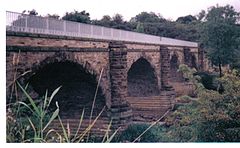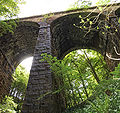- Viaduct
-
Viaduct 
Laigh Milton Viaduct in Ayrshire is the oldest surviving railway bridge in ScotlandAncestor Trestle bridge, Box girder bridge Related None Descendant None Carries Expressways, highways, streets, railroads Span range Short (multiple) Material reinforced concrete, prestressed concrete, masonry Movable No Design effort medium Falsework required available for use, since viaducts are all composed of low bridges. A viaduct is a bridge composed of several small spans. The term viaduct is derived from the Latin via for road and ducere to lead something. However, the Ancient Romans did not use that term per se; it is a modern derivation from an analogy with aqueduct.[citation needed] Like the Roman aqueducts, many early viaducts comprised a series of arches of roughly equal length. Viaducts may span land or water or both.
The longest viaduct in antiquity may have been the Pont Serme which crossed wide marshes in southern France.[1] Viaducts are commonly used in many cities which are railroad centers, such as Chicago, Atlanta, Birmingham, London, and Manchester. These viaducts cross the large railroad yards that are needed for freight trains there, and also cross the multi-track railroad lines that are needed for heavy railroad traffic. These viaducts keep highway and city street traffic from having to be continually interrupted by the train traffic.[citation needed] Likewise, some viaducts carry railroads over large valleys, or they carry railroads over cities with lots of cross-streets and avenues. The example of Viaduct on Expressways are Alabang Viaduct in South Luzon Expressway in Muntinlupa City, Philippines that crosses Alabang-Zapote Road in Barangay Alabang the viaduct reaches until Filinvest Interchange. In the north the Pulilan-Apalit Viaduct known as Candaba viaduct in North Luzon Expressway in Philippines is raised over the Candaba swamp from Pulilan, Bulacan until it reaches Apalit, Pampanga. This keeps the highway open to traffic, even when the swamp gets flooded during the rainy season. It has a view of Mt. Arayat, which is the lone mountain in Central Plain of Luzon.
Many viaducts over land connect points of similar height in a landscape, usually by bridging a river valley or other eroded opening in an otherwise flat area. Often such valleys had roads descending either side (with a small bridge over the river, where necessary) that become inadequate for the traffic load, necessitating a viaduct for "through" traffic.[2] Such bridges also lend themselves for use by rail traffic, which requires straighter and flatter routes.[3] Some viaducts have more than one deck, such that one deck has vehicular traffic and another deck having rail traffic. One example of this is the Prince Edward Viaduct in Toronto, Canada, that carries motor traffic on the top deck as Bloor Street, and metro as the Bloor-Danforth subway line on the lower deck, over the steep Don River valley. Others were built to span settled areas and crossed over roads beneath - the reason for many viaducts in London.
Viaducts over water are often combined with other types of bridges or tunnels to cross navigable waters. The viaduct sections, while less expensive to design and build than tunnels or bridges with larger spans, typically lack sufficient horizontal and vertical clearance for large ships. See the Chesapeake Bay Bridge-Tunnel.
The Millau Viaduct is a cable-stayed road-bridge that spans the valley of the River Tarn near Millau in southern France. Designed by the French bridge engineer Michel Virlogeux, in collaboration with architect Norman Robert Foster, it is the tallest vehicular bridge in the world, with one pier's summit at 343 metres (1,125 ft)—slightly taller than the Eiffel Tower and only 38 m (125 ft) shorter than the Empire State Building. It was formally dedicated on 14 December 2004 and opened to traffic two days later. The viaduct Danyang–Kunshan Grand Bridge in China is the longest bridge in the world according to Guinness World Records as of 2011[update].[4]
In Romance languages, the word viaduct refers to a bridge which spans only land. A bridge spanning water is called ponte.
Contents
Past and future
Elevated expressways were built in rich cities such as Boston (Central Artery), Seoul, Tokyo, Toronto (Gardiner Expressway).[5] But some were demolished because they were ugly and divided the city.[citation needed] However in developing nations such as Thailand, India (Delhi-Gurgaon Expressway), China, Bangladesh, Pakistan, elevated expressways have been built and more are under construction to improve traffic flow, particularly as a workaround of land shortage when built atop surface roads.[citation needed]
Gallery
-
The Canton Viaduct is an example of a blind arcade cavity wall.
-
Knaresborough viaduct is an elegant four-span bridge standing 78ft high above the River Nidd.
-
The Prince Edward Viaduct in Toronto is an example of a viaduct with multiple decks.
-
Railway viaduct crossing the Santa Ana River in Riverside, California, United States. Built in 1903.
-
The Alaskan Way Viaduct in Seattle, Washington, United States. To be demolished in 2012.
-
The Millau Viaduct, and the town of Millau, France on the right. It is the tallest bridge in the world.
References
- ^ Colin O’Connor: Roman Bridges, Cambridge University Press 1993, ISBN 0-521-39326-4, p. 99
- ^ Brownlee, Christy (March 2005) "Taking the high road: France's new bridge helps a small town dodge traffic—and set a new world record" SuperScience 16(6): pp.12–15;
- ^ Davidsen, Judith (April 1993) "A new "lite" rail viaduct formula: Norman Foster designs a rapid-transit viaduct for Rennes, France" Architectural Record 181(4): p.26;
- ^ Longest bridge, Guinness World Records. Last accessedd July 2011.
- ^ Toronto built, then demolished an expressway
External links
 Media related to Viaduct at Wikimedia Commons
Media related to Viaduct at Wikimedia Commons
Categories:- Viaducts
- Bridges
-
Wikimedia Foundation. 2010.







